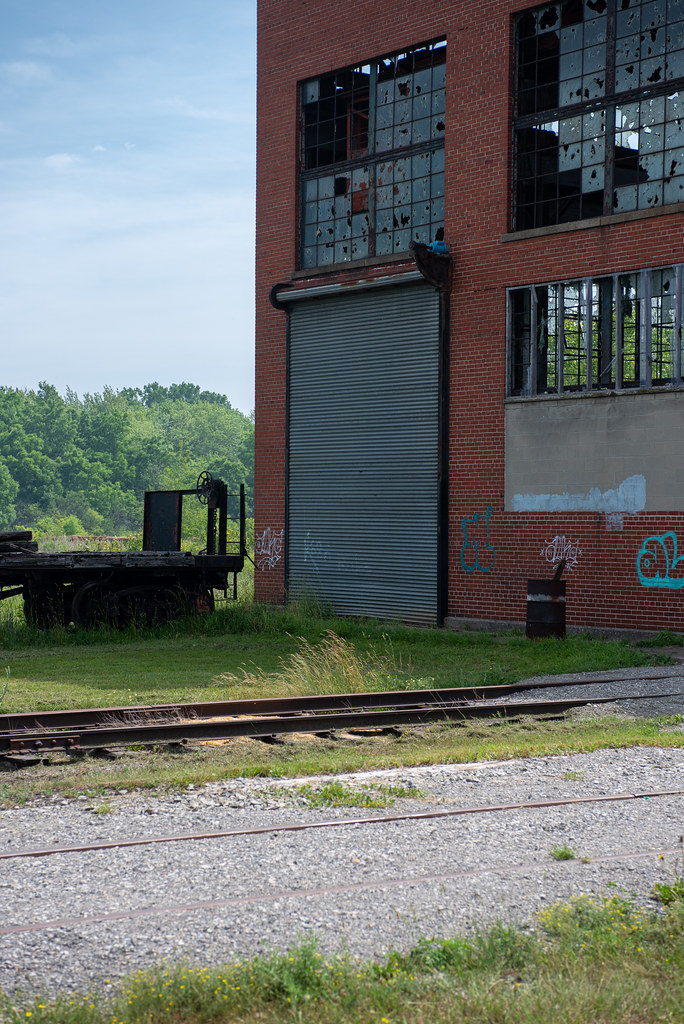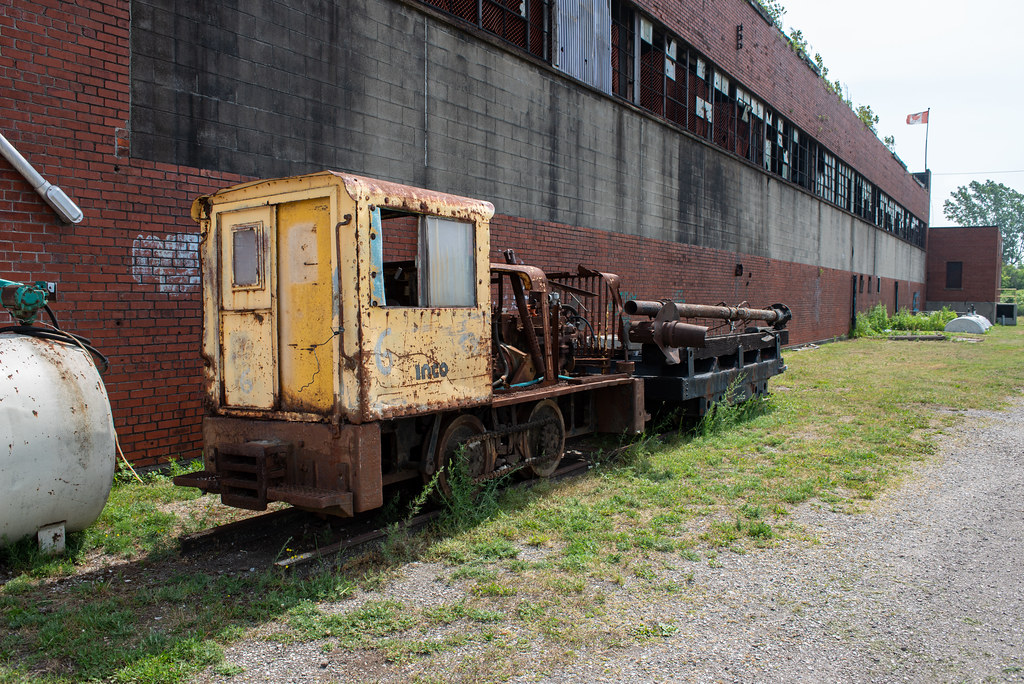Sitting well outside of the two historical downtowns within the community of Fort Erie sits several lonely buildings and overgrown tracks. These small remains are left of what was once a massive railway yard that had existed since the earliest days of the railway in Fort Erie but is today a mere shadow.

Graflex Crown Graphic – Fuji Fujinon-W 1:5.6/125 – Ilford HP5+ @ ASA-200 – Pyrocat-HD (1+1+100) 9:00 @ 20C
The Buffalo & Lake Huron Railway saw inception as a means to provide railway access to the people of Buffalo, Brantford and Goderich; the railways two main terminuses were Fort Erie and Goderich, where cars would be loaded onto massive rail ferries to be floating to destinations across bodies of water, at Fort Erie that was Black Rock in Buffalo. But as I mentioned in a previous entry, railway ferries were slow and had limited space, and at Fort Erie, only the International serviced the Buffalo & Lake Huron line. A large marshalling yard had to be purchased and constructed to maintain their trains, manage traffic, conduct maintenance, and store and shunt cars. Located outside the town of Fort Erie, these yards would form the core of the Buffalo & Lake Huron railway yards. Here trains would arrive and road locomotives stored and maintained in engine houses, roundhouses and a turntable, while shunting locomotives moved the cars to and from the ferry docks at the end of Bertie Street. Grand Trunk continued to operate the yards when they took over the entire Buffalo & Lake Huron network in 1864. From these yards, Grand Trunk employees sent out warning messages in July 1866 of the invading Fenians. They ensured that the trains and the International were sent out of reach and used by the Irish-American invaders. In 1873 with the completion of the International Railway Bridge, Grand Trunk saw a resurgence in the use of the Fort Erie Yards. While they had their primary motive power shops in Stratford to maintain their locomotive fleet, Fort Erie’s tracks were realigned to serve the new railway bridge and passenger stations in the new community of Bridgeburg. At the Fort Erie yards, more tracks were added to allow for storage and traffic control over the bridge and conduct maintenance on cars and locomotives travelling to and from the United States. By 1903 the Fort Erie or Warren Street Yards were the third-largest railway yards operated by Grand Trunk and directly affected the growth of both Bridgeburg and Fort Erie, providing several jobs for the surrounding area. By 1923 Canadian National had taken over operations at Warren Street.

Nikon D750 – AF-S Nikkor 28-70mm 1:2.8D
Nikon D750 – AF-S Nikkor 28-70mm 1:2.8D
One of the earliest uses of diesel-electric power on Canadian rails came in the form of yard switchers in the 1930s; these were small and less powerful than the massive Northern, Mountain, and Pacific type steam locomotives that drove the trains across the main road lines. These early switchers would have found a great deal of work at the Warren Street Yards, but by the 1950s, road-switchers were starting to take over the work of steam locomotives. Desiel motive power required a different type of maintenance facility. By the end of the 1950s, Canadian National began constructing new garages at Warren Street to support their diesel locomotives that now operated across the International Railway Bridge. Rather than keep all the original Grand Trunk buildings, Canadian National would, in the 1960s, begin the demolition of older steam-centred maintenance and storage buildings at Warren Street. Instead, Canadian National would open a new diesel maintenance garage in 1964, known as the Warren Street Shops. Many of the employees would arrive from Stratford as the Motive Power shops there closed that same year. The new shops were far smaller than previous maintenance buildings, with most of the yard continuing to be used as a traffic marshalling yard. Thankfully, the new shops maintained a workforce of four hundred and could conduction regular repairs and overhauls of most diesel-electric locomotives and switchers being used by Canadian National. These include the GP7 and GP9 road-switchers, SW1200 switchers, and many others. However, a decade after opening, Canadian National announced in 1977 that it would begin to move operations across the river to Black Rock. Operations would slowly wind down starting in 1978, and some employees were relocated to larger Canadian National Yards out in Western Canada. The final train would roll out of Warren Street in 1989, and the location shut its doors.

Nikon D750 – AF-S Nikkor 28-70mm 1:2.8D
Nikon D750 – AF-S Nikkor 28-70mm 1:2.8D
Canadian National would begin a systematic demolition of all but two buildings and start pulling up tracks. They also parcelled off the yard and sold it to local businesses, one of the largest being a scrapyard. The once large yard was cut to a fraction of its original size as some trackage was required for cross-bridge traffic. Because the railroad had been a huge employer, many soon found themselves out of work and drove the area into a depression, but it also drove many to seek a way to preserve the area’s rich railway heritage. The Niagara Railway Museum was the brainchild of Ken Jones Jr, who started collecting pieces of local railway history in 1994 and incorporated the museum two years later. Like any museum, first starting, they did not have a permanent home, and the collection was spread out across the member’s homes and storage units. And it was not small pieces; they had also acquired rolling stock from boxcars to switcher units, even a snowplough. They would need to locate a home quickly or risk losing their work. In 2010 they signed a lease agreement on the Warren Street Shop, but it had sat unused for near four decades. During that time, even I had attempted to gain access to the building, but it had been recently resealed, but I had seen photos from inside from other urban explorers. Although today, near two decades later, the museum remains in operation and offers limited access to the Warren Street Shops. The folks behind the museum have done an amazing job and are still looking for any artefacts related to the railroad in Fort Erie items before the closure of the shops. You can check the location out; it is best to go on a weekend with volunteers present, and always make sure to ask before going onto the property.
Just wondering if you by chance know any history on the buildings just ahead of the large railway. If you walk down 20 minutes there’s some sheds than an abandoned one floor building. I’m looking to find what building was used for.
Sadly I don’t know the history of those buildings.
Thank you regardless. This read was extremely informative and interesting! I much enjoyed and has been helpful too!